Looking for fresh and practical flower garden ideas that brighten your front yard and deliver year-round appeal with minimal maintenance? One of the easiest ways to transform your curb appeal is by adding easy-care trees that bring seasonal flowers, colorful foliage, and even bird-attracting berries to your landscape. These trees not only boost structure and shade but also make beautiful focal points when paired with perennials or layered flower beds.
In this guide, you’ll discover 10 low-maintenance trees that naturally elevate your favorite flower garden ideas—whether you’re planning for full sun, partial shade, or tricky soil. From backyard blooms to front yard foundations, these options align perfectly with thoughtful flower garden planning.
Table of Contents
1. Japanese Maple (Acer palmatum)
If you’re searching for flower garden ideas that bring elegance and a splash of color to your front yard, the Japanese Maple is a standout choice. These ornamental trees are prized for their sculptural form and breathtaking foliage, ranging from deep crimson to golden orange depending on the season and variety. Their compact size makes them ideal for small spaces or as a focal point amidst flowering perennials and shrubs.
Top Varieties to Consider:
- ‘Bloodgood’ – Deep red leaves that hold their color through summer
- ‘Coral Bark’ – Striking red branches in winter and bright green leaves in spring
- ‘Crimson Queen’ – Finely dissected leaves that turn a vibrant scarlet in fall
Growing Tips:
- USDA Zones: 5–9
- Sunlight: Partial shade to full sun (prefers afternoon shade in hot climates)
- Soil Needs: Well-drained, slightly acidic soil
- Mature Size: 15–25 feet tall and wide
- Deer Resistant: ❌
Pairing Japanese Maples with groundcovers or flowering plants like hellebores or hostas can inspire unique flower garden ideas that are both low-maintenance and visually captivating.
2. Dogwood (Cornus spp.)
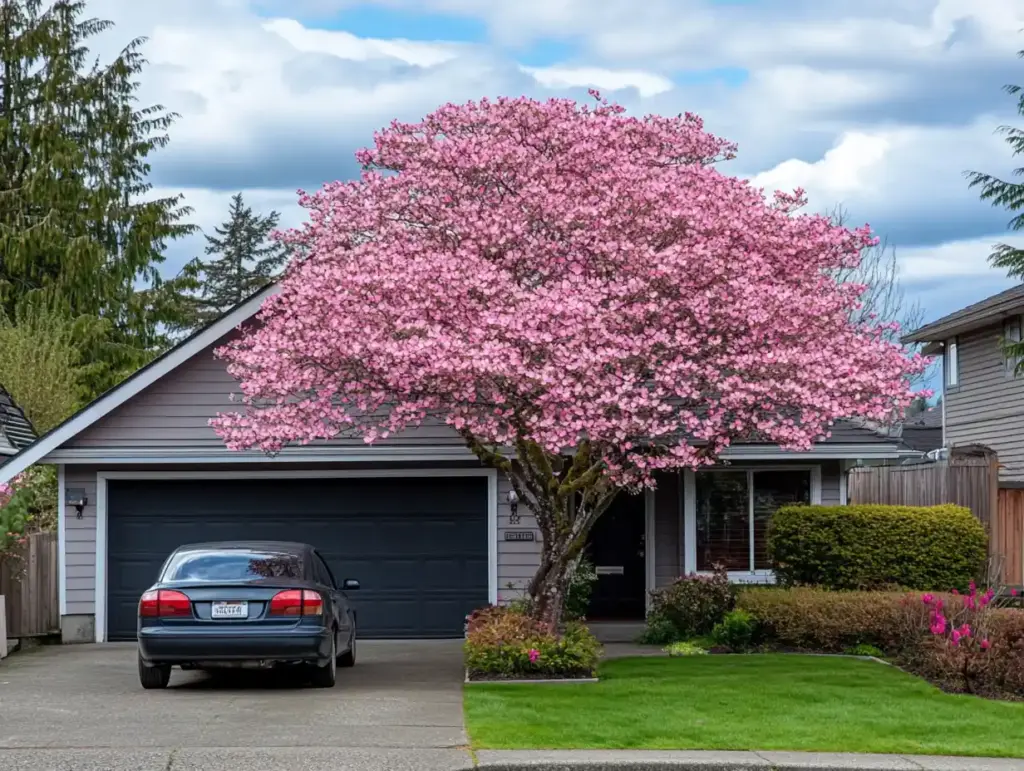
Dogwoods are the epitome of charm in front yard landscaping and are especially popular in flower garden ideas that prioritize seasonal interest. Known for their gracefully layered branches and showy spring blossoms, these trees create a soft, romantic vibe—perfect as a centerpiece or backdrop to blooming borders.
In spring, Dogwoods explode with delicate pink or white flowers, followed by summer berries and vibrant fall foliage. Their multiseason appeal makes them an excellent partner for flower beds, flowering groundcovers, or underplanting with shade-loving perennials.
Popular Varieties:
- Cornus florida – The classic native species with white spring flowers
- ‘Cherokee Brave’ – Rosy red blooms and good disease resistance
- Kousa Dogwood – Blooms later with pointed petals and produces strawberry-like fruit
Growing Tips:
- USDA Zones: 5–9
- Sunlight: Partial shade to full sun
- Soil Needs: Moist, well-drained soil rich in organic matter
- Mature Size: 15–30 feet tall, 15–25 feet wide
- Deer Resistant: ❌
Integrating Dogwoods into your flower garden ideas adds both structure and softness. Consider planting them alongside early-blooming bulbs like crocuses or daffodils for a layered spring effect.
3. Crape Myrtle (Lagerstroemia indica)

Crape Myrtles are a favorite among gardeners seeking flower garden ideas that pop with long-lasting color and architectural interest. These deciduous trees bloom profusely from midsummer to early fall in shades of white, pink, red, and purple. Their peeling bark adds year-round texture, making them both a floral and structural asset to any front yard design.
Compact varieties can line walkways or serve as a centerpiece in a flower bed, while taller cultivars are perfect for anchoring landscape designs or providing filtered shade for sun-loving perennials.
Standout Features:
- Extended summer bloom period
- Exfoliating bark with patchwork patterns
- Drought-tolerant once established
Growing Tips:
- USDA Zones: 6–10
- Sunlight: Full sun
- Soil Needs: Well-drained, slightly acidic to neutral
- Mature Size: 15–25 feet tall, 6–15 feet wide (varies by cultivar)
- Deer Resistant: ✅
For bold flower garden ideas, pair a deep-pink Crape Myrtle with gold or purple-toned annuals and perennials for maximum visual contrast. Their height and colorful blooms make them ideal for layering in large garden beds.
4. Dwarf Alberta Spruce (Picea glauca ‘Conica’)
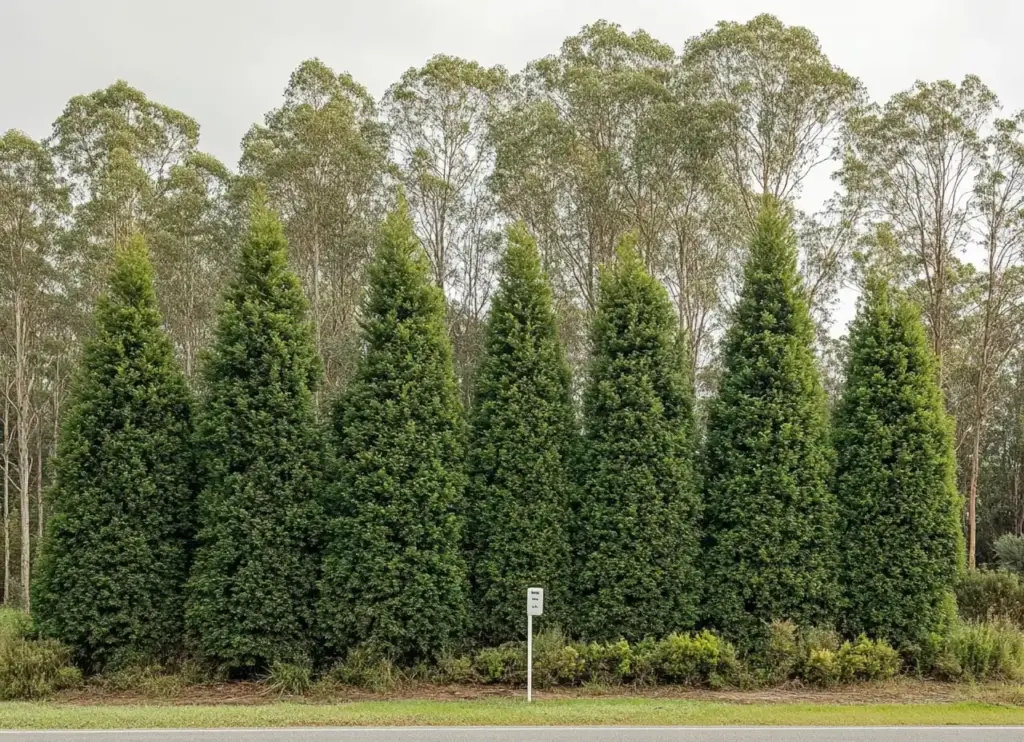
When exploring flower garden ideas with year-round structure and symmetry, the Dwarf Alberta Spruce stands out as a reliable evergreen option. Its naturally conical shape and compact growth habit make it ideal for flanking entryways, lining walkways, or adding evergreen contrast to colorful seasonal blooms.
Unlike more sprawling trees, this spruce variety stays neatly shaped with minimal pruning, making it a top choice for low-maintenance landscaping that complements both formal and cottage-style gardens.
Why It Works in Front Yards:
- Compact and tidy growth habit
- Provides evergreen interest during winter
- Great for containers, borders, or as vertical accents in flower beds
Growing Tips:
- USDA Zones: 2–6
- Sunlight: Full sun to partial shade
- Soil Needs: Well-drained, slightly acidic soil
- Mature Size: 10–13 feet tall, 7–10 feet wide
- Deer Resistant: ❌
To elevate your flower garden ideas, surround this evergreen with seasonal color—think tulips in spring, lavender in summer, and mums in fall—for a layered look that stays vibrant year-round.
5. Flowering Cherry (Prunus spp.)
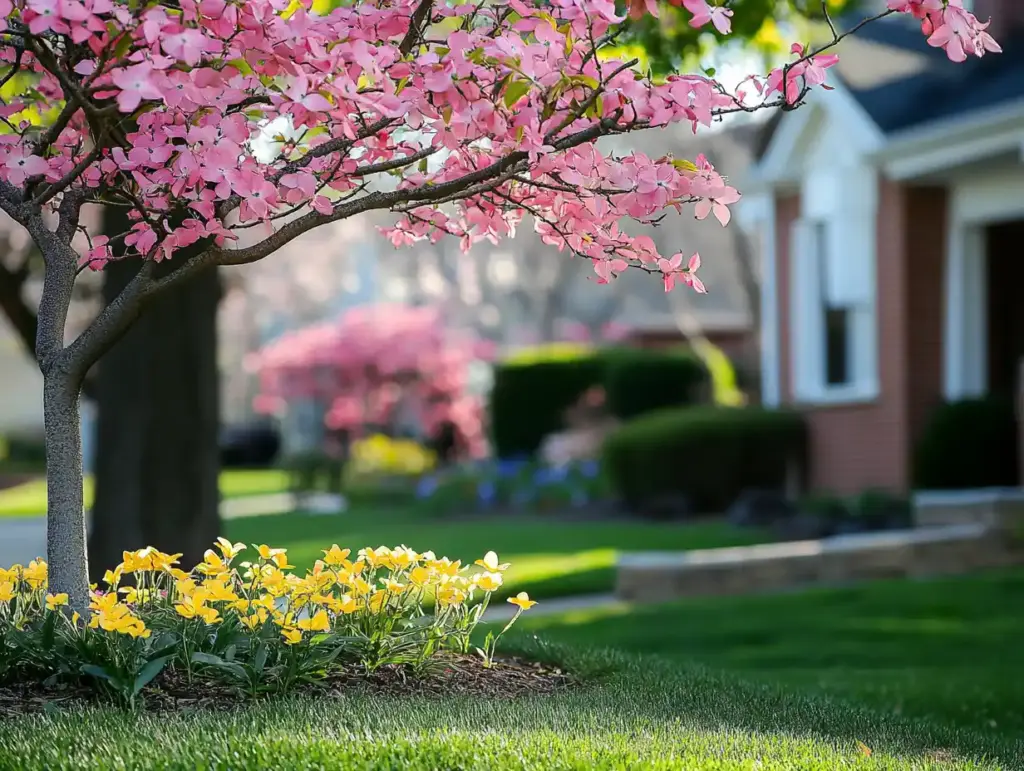
Few trees capture the spirit of spring quite like the Flowering Cherry. If your flower garden ideas lean toward whimsical beauty and vibrant seasonal displays, this tree is a must-have. Its iconic pink or white blossoms arrive in early spring, often before the leaves emerge, creating a magical burst of color that instantly enhances curb appeal.
Flowering Cherries also offer attractive bark and a rounded canopy that adds shade and structure during the growing season—perfect for pairing with colorful bulbs or low-growing perennials.
Favorite Varieties:
- Yoshino Cherry – Pale pink to white blooms with a weeping shape
- ‘Kwanzan’ Cherry – Double pink blossoms and rich fall foliage
- Weeping Cherry – Graceful, arching branches with a fountain-like form
Growing Tips:
- USDA Zones: 5–8
- Sunlight: Full sun
- Soil Needs: Moist, well-drained, slightly acidic soil
- Mature Size: 15–30 feet tall and wide (varies by species)
- Deer Resistant: ❌
Flowering Cherries pair beautifully with spring bulbs like hyacinths or tulips. Use them to anchor your flower garden ideas around seasonal bloom timing for a coordinated, eye-catching display.
6. Redbud (Cercis canadensis)
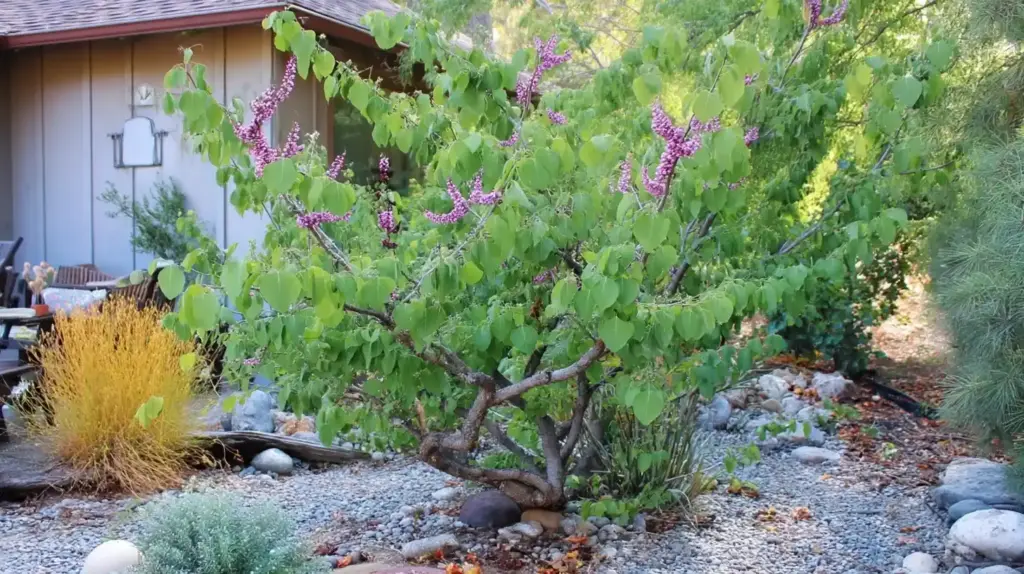
For gardeners who love early-season color and unique foliage, the Redbud is a front-yard favorite. It’s especially valuable in flower garden ideas that aim to bring charm and a touch of the unexpected. In early spring, before the leaves emerge, Redbuds burst with clusters of tiny, purple-pink flowers that cling directly to branches and even the trunk—a trait called “cauliflory.”
Once the blooms fade, heart-shaped leaves unfurl, creating a soft, elegant canopy that works beautifully above layered flower beds or underplanted shade gardens.
Notable Features:
- Brilliant purple or pink flowers in early spring
- Heart-shaped foliage in green, burgundy, or gold
- Great for pollinators and early-season interest
Growing Tips:
- USDA Zones: 4–9
- Sunlight: Full sun to partial shade
- Soil Needs: Well-drained; tolerates clay and a variety of soil types
- Mature Size: 20–30 feet tall, 15–25 feet wide
- Deer Resistant: ❌
Incorporate Redbuds into your flower garden ideas by planting beneath them with contrasting textures—ferns, bleeding hearts, or coral bells—for a layered woodland aesthetic that thrives in dappled light.
7. Magnolia (Magnolia spp.)
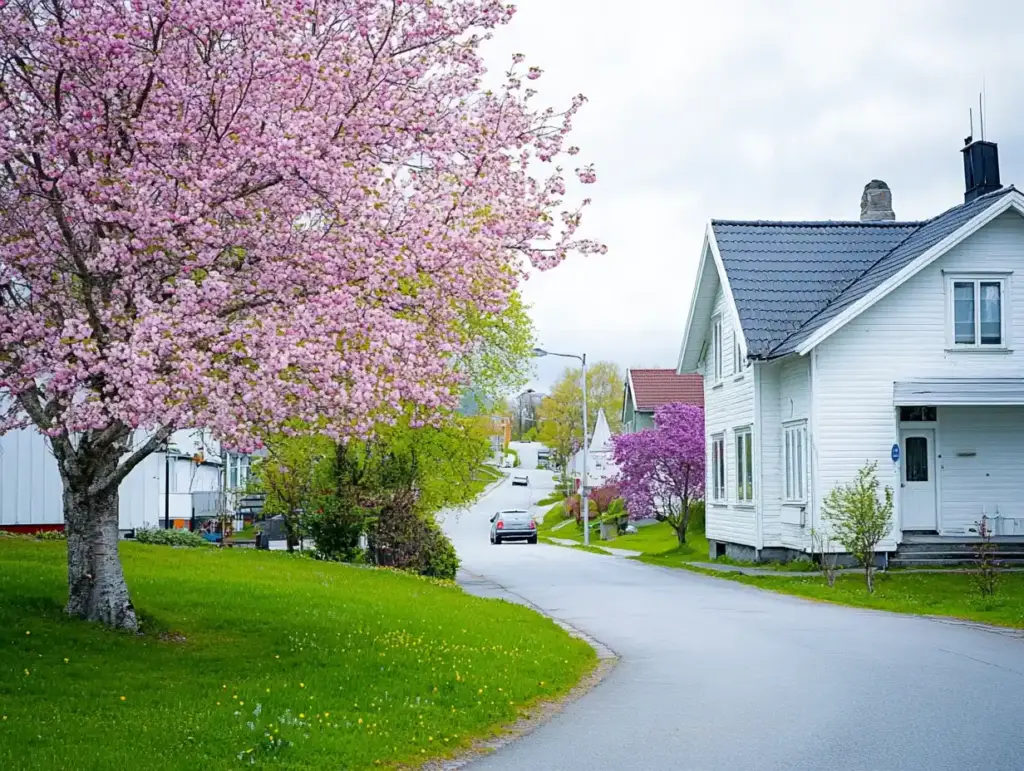
Magnolias bring bold beauty and fragrant blooms to any landscape, making them a powerful addition to flower garden ideas that emphasize both structure and softness. Known for their large, creamy white or pink blossoms, Magnolias can create a dramatic focal point in front yards, especially in spring when they bloom ahead of the foliage.
With evergreen and deciduous varieties available, you can choose a Magnolia that suits your climate and space—some stay compact, while others grow into stately shade trees.
Types to Consider:
- Southern Magnolia (Magnolia grandiflora) – Evergreen with giant, fragrant white blooms
- Saucer Magnolia (Magnolia × soulangeana) – Deciduous, with showy pink-purple flowers
- Star Magnolia (Magnolia stellata) – Early bloomer with delicate white, star-shaped petals
Growing Tips:
- USDA Zones: 3–9 (varies by species)
- Sunlight: Full sun to partial shade
- Soil Needs: Well-drained, rich, slightly acidic soil
- Mature Size: 20–80 feet tall, 10–40 feet wide (depending on species)
- Deer Resistant: ❌
To incorporate Magnolias into your flower garden ideas, plant them as a statement piece surrounded by low-maintenance flowering shrubs or early-spring bulbs that won’t compete with their shallow roots.
8. Crabapple (Malus spp.)
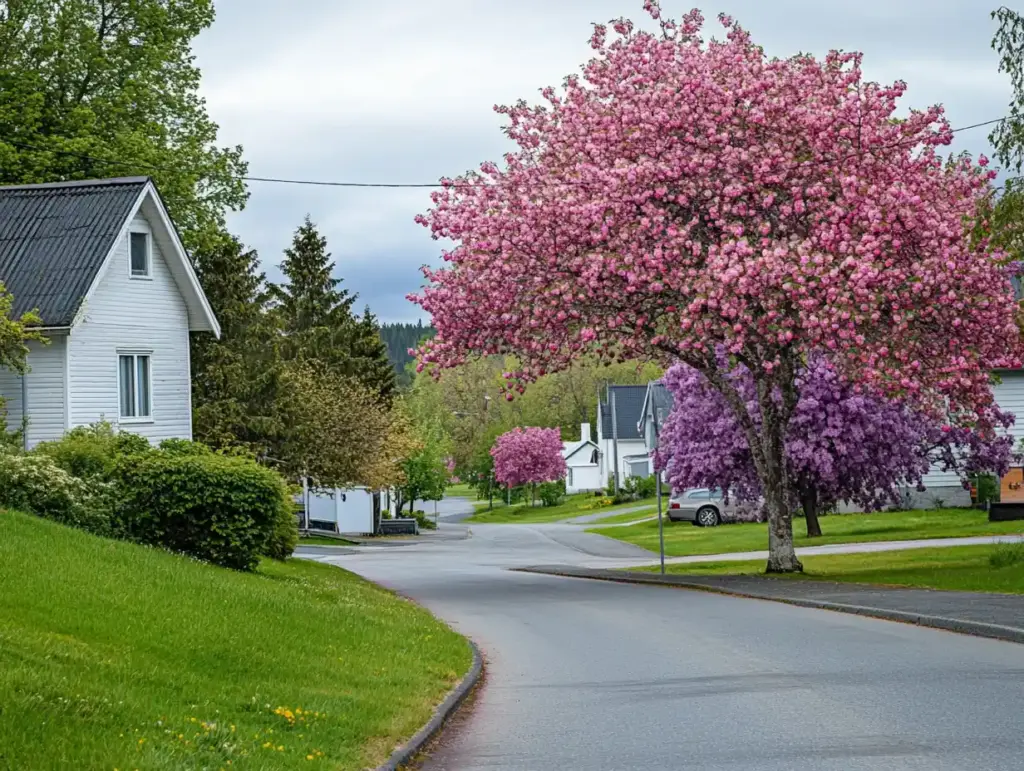
Crabapple trees are a vibrant, multi-season addition to any front yard and are especially appealing for flower garden ideas that focus on beauty and biodiversity. These trees deliver a strong spring performance with dense clusters of white, pink, or red blossoms, followed by colorful fruit that persists into fall and attracts birds.
Their compact form and ornamental appeal make them ideal for pairing with perennial flower beds or as standalone accent trees near pathways or garden entrances.
Key Benefits:
- Spring flowers in a range of shades
- Small, ornamental fruit adds fall and winter interest
- Attracts birds and pollinators
Growing Tips:
- USDA Zones: 4–8
- Sunlight: Full sun
- Soil Needs: Moist, well-drained, slightly acidic to neutral
- Mature Size: 15–25 feet tall and wide (varies by cultivar)
- Deer Resistant: ❌
Enhance your flower garden ideas by underplanting Crabapples with low-growing blooms like creeping phlox or daffodils, which complement their spring show and extend seasonal color.
9. Serviceberry (Amelanchier spp.)

If you’re drawn to flower garden ideas that offer four-season beauty, the Serviceberry is a tree you’ll want to consider. This North American native is beloved for its elegant white spring blossoms, edible summer berries, fiery fall foliage, and smooth, silvery bark that stands out in winter.
Its moderate size and multi-stemmed habit make it an excellent choice for small yards or as a graceful backdrop to flowering borders. Bonus: the berries are a hit with birds—and even humans if you enjoy a tart garden snack!
Highlights:
- White blooms in early spring
- Edible, blueberry-like fruit in summer
- Brilliant fall color ranging from orange to deep red
Growing Tips:
- USDA Zones: 3–9
- Sunlight: Full sun to partial shade
- Soil Needs: Moist, well-drained soil, slightly acidic to neutral
- Mature Size: 15–25 feet tall and wide
- Deer Resistant: ❌
For layered flower garden ideas, plant Serviceberries alongside early bloomers like primroses or violets, then follow up with summer favorites like salvia or daylilies for continuous color and contrast.
10. Eastern Red Cedar (Juniperus virginiana)
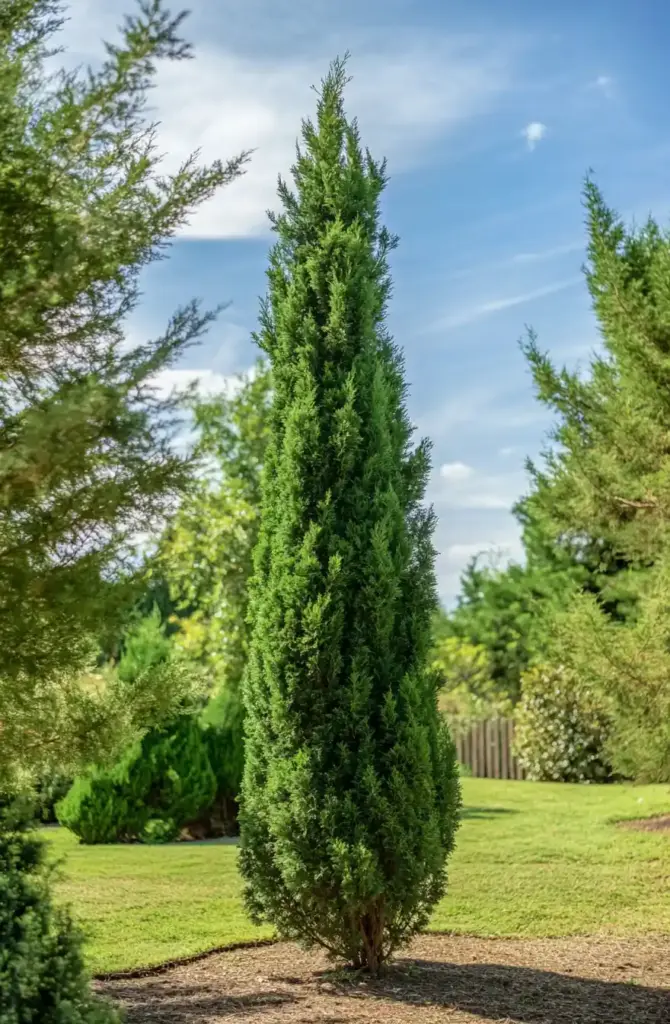
For low-maintenance landscaping with privacy and year-round greenery, Eastern Red Cedar is a dependable choice—especially if your flower garden ideas include evergreen structure or wildlife habitat. This hardy native conifer tolerates poor soils, drought, wind, and cold, making it ideal for challenging spots where other trees may struggle.
Its dense, pyramidal form works well as a natural screen or backdrop for flowering borders, and its small blue berries attract birds throughout the colder months.
Key Advantages:
- Evergreen foliage for year-round visual interest
- Highly tolerant of harsh conditions
- Excellent for windbreaks, privacy screens, or wildlife gardens
Growing Tips:
- USDA Zones: 2–9
- Sunlight: Full sun
- Soil Needs: Adaptable; prefers well-drained soil
- Mature Size: 40–50 feet tall, 8–20 feet wide
- Deer Resistant: ✅
Eastern Red Cedar’s rugged nature complements vibrant flower garden ideas—try pairing it with drought-tolerant blooms like echinacea, black-eyed Susans, or ornamental grasses for a striking, sustainable front yard design.
Frequently Asked Questions (FAQ)
What are the best trees to complement flower garden ideas?
Trees like Japanese Maple, Redbud, and Flowering Cherry are perfect for flower gardens due to their colorful blooms, manageable size, and seasonal interest. These trees can serve as focal points or provide filtered shade for shade-loving perennials.
Can I plant flowering trees in small front yards?
Yes! Many of the trees listed, such as Dwarf Alberta Spruce, Serviceberry, and Crape Myrtle, are compact enough for small yards. Choose varieties labeled “dwarf” or “ornamental” to keep proportions balanced with your landscape.
How do I choose trees that match my local climate?
Always check the USDA Hardiness Zone listed for each tree. This ensures the tree can survive your area’s winter lows. Also, consider sunlight, soil conditions, and water availability to make the best choice.
Do flowering trees require a lot of maintenance?
Not necessarily. Most trees on this list are low-maintenance once established. Occasional pruning, mulching, and watering during dry spells are usually all that’s needed. They pair well with easy-care flower garden ideas for a stress-free landscape.
Can I grow trees and flowers together in the same bed?
Absolutely. Just ensure the flower types are compatible with the tree’s light and root conditions. For example, shade-loving plants like hostas or hellebores do well under Dogwoods or Japanese Maples, while sun-loving blooms like coneflowers pair well with Crape Myrtle or Crabapple.
Conclusion
Transforming your front yard into a stunning, low-maintenance retreat is easier than you think. By incorporating these easy-care trees into your landscape, you’ll add structure, shade, and vibrant seasonal color—all while enhancing your overall flower garden ideas. Whether your goal is to attract pollinators, showcase spring blooms, or frame colorful perennial beds, these trees offer beauty and ease in every season.
Take your design even further by pairing flowering trees with low-maintenance shrubs, bulbs, or groundcovers to create a layered garden that blooms with personality. And remember—some of the most timeless flower garden ideas begin not with petals, but with the perfect tree.


